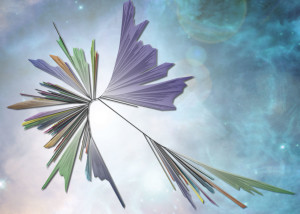Cultivation-independent methods and bioinformatics have dramatically expanded the number of available genome sequences.
The Science
Using publicly available data sets from multiple sources, including the DOE Joint Genome Institute’s data management system, researchers have reorganized the tree of life to reflect the over 30,000 eukaryote, bacterial and archaeal genomes now known.

An artistic representation of the tree of life, with the many groups of bacteria on the left, the uncultivable bacteria at upper right (purple), and the Archaea and eukaryotes (green) – which includes humans – at the lower right. (Graphic by Zosia Rostomian, Berkeley Lab)
The Impact
The expansion of the tree of life highlights the impact of advances in sequencing technologies that have allowed researchers to fill in previously unknown gaps of information. Additionally, the work emphasizes how much microbial diversity has been made accessible only through cultivation-independent techniques such as single-cell genomics and metagenomics.
Summary
Nearly 30 years ago, microbiologist Carl Woese radically proposed that the Tree of Life had a third branch – Archaea – rather than the two comprised of Eukarya and Bacteria. In a study published April 11, 2016 in Nature Microbiology, and with help from the U.S. Department of Energy Joint Genome Institute (JGI), a DOE Office of Science User Facility, a team led by longtime JGI collaborator Jill Banfield of UC Berkeley features a new depiction of the tree of life that better reflects the microbial diversity revealed through cultivation-independent techniques and bioinformatics methods. The team utilized the 30,437 eukaryote, bacterial and archaeal genomes publicly accessible through the JGI’s Integrated Microbial Genomes (IMG) database, and 1,011 newly-reconstructed genomes from previously uncharacterized lineages. The work builds off previous studies by the Banfield lab in which over 35 new groups or phyla of bacteria and nine new groups of archaea were identified. Many of the bacteria identified in the earlier study were sequenced as part of a 2015 JGI Community Science Program (CSP) project that involved groundwater samples from a bioremediation site at Rifle, Colorado. This CSP project is also part of the Berkeley Lab Genomes-to-Watershed Scientific Focus Area (SFA), which involves over 50 scientists from Berkeley Lab and other institutions including UC Berkeley, Pacific Northwest National Laboratory, Colorado School of Mines, and Oak Ridge National Laboratory.
With more accurate perspectives on microbial diversity and their relationships, scientists can make better inferences about adaptations to different environments which can lead to discoveries of new enzymes and pathways to help address DOE missions in bioenergy and environmental processes.
Contacts
Daniel Drell, Ph.D.
Program Manager
Biological Systems Sciences Division
Office of Biological and Environmental Research
Office of Science
US Department of Energy
daniel.drell@science.doe.gov
Jill Banfield
UC Berkeley
jbanfield@berkeley.edu
Funding
- DOE Office of Science
- NASA
- National Science Foundation
- Office of Naval Research
- Thomas C. and Joan M. Merigan Endowment at Stanford University
- Ministry of Economy, Trade and Industry of Japan
Publications
- Hug LA et al. A new view of the tree of life. Nat Microbiol. (2016). doi: 10.1038/nmicrobiol.2016.48.
Related Links
- http://news.berkeley.edu/2016/04/11/wealth-of-unsuspected-new-microbes-expands-tree-of-life/
- Video: http://bit.ly/RC15Banfield
- http://archive.jgi.doe.gov/jillian-banfield-university-of-california-berkeley/
- http://archive.jgi.doe.gov/subsurface-microbiology-for-gewasc-modelling/
- http://archive.jgi.doe.gov/longer-dna-fragments-reveal-rare-species-diversity/
- http://esd1.lbl.gov/research/projects/sustainable_systems/
- http://news.berkeley.edu/2015/06/15/newfound-groups-of-bacteria-are-mixing-up-the-tree-of-life/
- http://www.nytimes.com/2016/04/12/science/scientists-unveil-new-tree-of-life.html
- http://news.utexas.edu/2016/04/11/scientists-unveil-most-comprehensive-genomic-tree-of-life